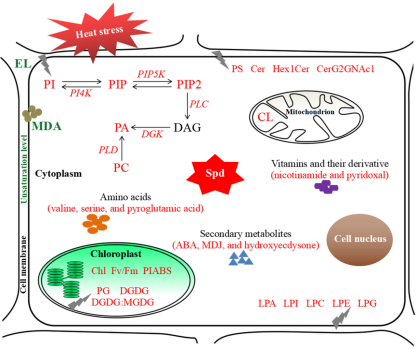DOI:doi.org/10.3390/ijms232012247
发表期刊:International Journal of Molecular Sciences
链接:https://www.mdpi.com/1422-0067/23/20/12247
作者:Zhou Li#, Bizhen Cheng#, Yue Zhao, Lin Luo, Yan Zhang, Guangyan Feng, Liebao Han, Yan Peng* and Xinquan Zhang*
Abstract:Beneficial effects of spermidine (Spd) on alleviating abiotic stress damage have been explored in plants for hundreds of years, but limited information is available about its roles in regulating lipids signaling and metabolism during heat stress. White clover (Trifolium repens) plants were pretreated with 70 µM Spd and then subjected to high temperature (38/33℃) stress for 20 days. To further investigate the effect of Spd on heat tolerance, transgenicArabidopsis thalianaoverexpressing aTrSAMSencoding a key enzyme involved in Spd biosynthesis was exposed to high temperature (38/33℃) stress for 10 days. A significant increase in endogenous Spd content in white clover by exogenous application of Spd or theTrSAMSoverexpression inArabidopsis thalianacould effectively mitigate heat-induced growth retardation, oxidative damage to lipids, and declines in photochemical efficiency and cell membrane stability. Based on the analysis of metabolomics, the amino acids and vitamins metabolism, biosynthesis of secondary metabolites, and lipids metabolism were main metabolic pathways regulated by the Spd in cool-season white clover under heat stress.

Further analysis of lipidomics found theTrSAMS-transgenic plants maintained relatively higher accumulations of total lipids, eight phospholipids (PC, phosphatidylcholine; PG, phosphatidylglycerol; PS, phosphatidylserine; CL, cardiolipin; LPA, lysophosphatidic acid; LPC, lyso phosphatidylcholine; LPG, lyso phosphatidylglycerol; and LPI, lyso phosphatidylinositol), one glycoglycerolipid (DGDG, digalactosyl diacylglycerol), and four sphingolipids (Cer, ceramide; CerG2GNAc1, dihexosyl N-acetylhexosyl ceramide; Hex1Cer, hexosyl ceramide; and ST, sulfatide), higher ratio of DGDG: monogalactosyl diacylglycerol (MGDG), and lower unsaturation level than wild-typeArabidopsis thalianain response to heat stress. Spd-induced lipids accumulation and remodeling could contribute to better maintenance of membrane stability, integrity, and functionality when plants underwent a long period of heat stress. In addition, the Spd significantly up-regulated PIP2 and PA signaling pathways, which was beneficial to signal perception and transduction for stress defense. Current findings provide a novel insight into the function of Spd against heat stress through regulating lipids signaling and reprograming in plants.